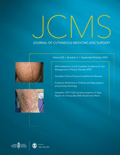
JOURNAL OF CUTANEOUS MEDICINE AND SURGERY
Scope & Guideline
Elevating standards in skin care and surgical techniques.
Introduction
Aims and Scopes
- Clinical Dermatology:
The journal publishes studies that detail clinical findings, treatment outcomes, and management strategies for various dermatological conditions, including acne, psoriasis, eczema, and skin cancers. - Surgical Dermatology:
Research related to surgical interventions in dermatology, such as Mohs micrographic surgery, is a core focus. The journal highlights techniques, outcomes, and complications associated with surgical procedures. - Innovative Therapies:
The publication includes studies on emerging therapies and treatment modalities, particularly biologics and targeted therapies, addressing their efficacy, safety, and patient outcomes. - Patient-Centered Research:
The journal emphasizes patient perspectives, quality of life, and psychological impacts of dermatological conditions and treatments, reflecting a holistic approach to skin health. - Teledermatology and Digital Health:
With the rise of telemedicine, the journal explores the integration and effectiveness of digital health solutions in dermatology, including teledermatology practices and patient education through online platforms. - Diversity and Inclusivity in Dermatology:
The journal is committed to discussing issues of diversity, representation, and healthcare disparities in dermatology, particularly focusing on underrepresented populations and their specific needs.
Trending and Emerging
- Biologics and Targeted Therapies:
There is a significant increase in research related to the efficacy and safety of biologics and targeted therapies for chronic skin conditions, such as psoriasis, atopic dermatitis, and hidradenitis suppurativa. - Artificial Intelligence in Dermatology:
Emerging studies are exploring the application of artificial intelligence and machine learning in dermatology, particularly for diagnostic purposes and treatment planning, showcasing the integration of technology into clinical practice. - Telemedicine and Remote Care:
The rise of teledermatology has led to a surge in studies examining its effectiveness, patient satisfaction, and outcomes, particularly in the context of the COVID-19 pandemic, highlighting a shift towards more accessible healthcare. - Psychodermatology and Mental Health:
Research focusing on the intersection of dermatology and mental health is gaining traction, emphasizing the psychological impact of skin diseases and the importance of addressing mental well-being in treatment plans. - Health Disparities and Inclusivity:
The journal is increasingly publishing articles that address health disparities among different demographic groups, emphasizing the need for inclusive practices in dermatology and research. - Patient Education and Involvement:
There is a growing emphasis on patient education, self-management strategies, and the incorporation of patient feedback into treatment protocols, reflecting a shift towards more patient-centered care.
Declining or Waning
- Traditional Pharmacotherapy:
There has been a noticeable decrease in the publication of studies focusing solely on traditional pharmacotherapy for common dermatological conditions, such as topical corticosteroids, as newer therapies and biologics gain prominence. - Basic Science Research:
Research that delves into the fundamental mechanisms of skin diseases at the molecular or cellular level appears to be less frequent, possibly overshadowed by clinical and translational studies that prioritize immediate patient care. - Epidemiological Studies:
The number of epidemiological studies examining skin diseases in broad populations has declined, suggesting a shift towards more targeted research that addresses specific conditions or patient demographics. - General Dermatology Reviews:
While comprehensive reviews remain important, there seems to be a reduction in general review articles that cover broad topics without a specific focus, as the journal leans more towards specialized and innovative research.
Similar Journals

AUSTRALASIAN JOURNAL OF DERMATOLOGY
Pioneering insights in dermatological advancements.Australasian Journal of Dermatology is a leading publication in the field of dermatology, issued by Wiley since 1951, and reaching an audience of researchers, clinicians, and students interested in the latest advancements and practices in skin health. With an ISSN of 0004-8380 and an E-ISSN of 1440-0960, this journal stands out with its Q2 ranking in both Dermatology and Miscellaneous Medicine, positioning it within the top 61st percentile of its category according to Scopus. Although it does not provide Open Access options, Australasian Journal of Dermatology is committed to disseminating high-quality research that informs clinical practices and promotes scholarly dialogue. By publishing rigorous and peer-reviewed articles focused on various aspects of dermatological science, the journal plays a pivotal role in enhancing the dermatology community's understanding of skin conditions and treatments, making it an invaluable resource for professionals and students alike.

AMERICAN SURGEON
Unveiling the Future of Surgery with Every Publication.AMERICAN SURGEON, published by SAGE Publications Inc, is a preeminent journal dedicated to the field of surgery, with a particular emphasis on disseminating significant contributions to surgical techniques, clinical practices, and healthcare innovations. Established in 1951, this journal has a comprehensive coverage that extends until 2024, although it is noted that its indexing in Scopus has been discontinued. The journal currently holds a strong position in the academic community, evident from its categorization in the Q3 quartile for Medicine (Miscellaneous) and Q2 for Surgery, reflecting its relevance in the medical literature landscape. With an impact factor that signifies its academic influence, AMERICAN SURGEON serves as an essential resource for researchers, professionals, and students looking to stay abreast of the latest surgical findings and methodologies. The journal does not offer open access, which adds to its exclusive nature, ensuring that published articles undergo rigorous peer review, thus maintaining high scholarly standards.

JOURNAL OF DERMATOLOGICAL TREATMENT
Exploring the forefront of skin health research.The JOURNAL OF DERMATOLOGICAL TREATMENT, published by TAYLOR & FRANCIS LTD, is a premier forum dedicated to advancing the field of dermatology through the dissemination of high-quality research. Since its inception in 1989, this journal has maintained a significant impact on the dermatological community, currently ranking in the top quartile (Q1) of the Dermatology category with an impressive Scopus ranking of #14 out of 142 journals, reflecting its reputation among peers and its contribution to the clinical and academic landscape. The journal shifted to Open Access in 2023, enhancing the accessibility of groundbreaking findings to researchers, clinicians, and students worldwide. With a commitment to publishing diverse articles, from innovative treatment modalities to comprehensive reviews, the JOURNAL OF DERMATOLOGICAL TREATMENT serves as an invaluable resource for professionals seeking to stay at the forefront of dermatological science in a rapidly evolving field.

Surgical Oncology Clinics of North America
Innovative Insights for Surgical ExcellenceSurgical Oncology Clinics of North America, published by W B Saunders Co-Elsevier Inc, is a leading journal in the fields of surgical oncology and surgery, captivating readers since its inception in 1995. With ISSN 1055-3207 and E-ISSN 1558-5042, this esteemed journal offers a comprehensive platform for the dissemination of cutting-edge research, clinical studies, and expert reviews pertaining to surgical techniques and oncological advancements. The journal currently holds a commendable Q3 ranking in Oncology and a Q2 ranking in Surgery, underpinned by its impressive Scopus rankings that place it in the top 25% of its category in Medicine, particularly in the surgical domain (Rank #137/551). Although it does not operate under an open-access model, the insights shared within its pages are invaluable for researchers, healthcare professionals, and students dedicated to enhancing patient outcomes in surgical oncology. With a commitment to advancing medical knowledge, Surgical Oncology Clinics of North America remains a crucial resource for those pursuing excellence in surgical practices and oncology treatment methodologies.

Turkderm-Turkish Archives of Dermatology and Venerology
Empowering Dermatology with Unrestricted KnowledgeTurkderm - Turkish Archives of Dermatology and Venerology, published by GALENOS PUBL HOUSE, serves as a vital platform for the dissemination of innovative research and advancements in the fields of dermatology and venerology. With an Open Access policy implemented since 2002, this journal aims to provide free and unrestricted access to significant findings, ensuring that vital information reaches a global audience. Based in Turkey, the journal has positioned itself as an important resource for professionals, researchers, and students alike, despite currently being categorized in Q4 of both Dermatology and Infectious Diseases as per the 2023 metrics. Although it faces competition in the rankings, with a Scopus standing of #131 in Dermatology and #331 in Infectious Diseases, its dedication to advancing knowledge in these critical health areas is unwavering. The journal continually invites original research, reviews, and case studies that enhance clinical practices and foster understanding in the dermatological community.

CURRENT TREATMENT OPTIONS IN ONCOLOGY
Navigating the Evolving Landscape of Cancer CareCURRENT TREATMENT OPTIONS IN ONCOLOGY, published by Springer, is a premier academic journal dedicated to disseminating cutting-edge research and advancements in the field of oncology and pharmacology. With a commendable impact factor and ranked in the Q1 category in both oncology and pharmacology for 2023, this journal positions itself as a leading resource for researchers, healthcare professionals, and students alike, offering insightful reviews and original articles that critically evaluate treatment methodologies and clinical practices. Covering a wide scope of topics from early detection to innovative therapies, it fosters the translation of research findings into clinical applications. With its convergence years spanning from 2000 to 2024, CURRENT TREATMENT OPTIONS IN ONCOLOGY continues to be at the forefront of oncological research, providing a platform for scholars to explore the latest therapeutic options and improve patient outcomes. Highly regarded in the academic community, this journal is essential for anyone looking to stay informed about the dynamic landscape of cancer treatment.

JAMA Dermatology
Advancing Dermatological Discoveries for a Healthier Future.JAMA Dermatology, an esteemed publication by the American Medical Association, is positioned at the forefront of dermatological research and clinical practice. With an ISSN of 2168-6068 and an E-ISSN of 2168-6084, this journal underscores a commitment to disseminating high-quality and impactful research within the field. Notably ranked Q1 in both Dermatology and Miscellaneous Medicine for 2023, JAMA Dermatology ranks among the top journals in its category, holding the impressive 3rd position out of 142 in Scopus's dermatology rankings, placing it in the 98th percentile. With converged years extending from 2013 to 2024, the journal emphasizes timely and critical advancements in dermatological science. Furthermore, as a champion of open access, it encourages a broad dissemination of knowledge, making essential research accessible to a wider audience. Researchers, professionals, and students alike will find JAMA Dermatology to be an invaluable resource for the latest findings, innovative therapies, and in-depth reviews that shape the future of dermatological health.

ABCD-Arquivos Brasileiros de Cirurgia Digestiva-Brazilian Archives of Digestive Surgery
Exploring New Frontiers in Digestive SurgeryABCD-Arquivos Brasileiros de Cirurgia Digestiva-Brazilian Archives of Digestive Surgery is a reputable open access journal published by the Colégio Brasileiro de Cirurgia Digestiva (CBCD), dedicated to advancing the field of digestive surgery. With a focus on the latest research and clinical practices, the journal has been instrumental since its inception in fostering knowledge sharing within the surgical community. Its impressive impact factor and inclusion in renowned databases underscore its significance, particularly in gastroenterology and surgery, as evidenced by its 2023 quartile rankings of Q3 in Gastroenterology and Medicine, and Q2 in Surgery. Accessible since 2017, ABCD not only bridges the gap between research and practice in Brazil but also globally as researchers, professionals, and students contribute and gain insights into innovative surgical techniques and outcomes. Based in São Paulo, Brazil, the journal covers a broad spectrum of topics in digestive health and serves as a crucial resource for anyone passionate about surgery and medicine.

Journal of Dermatology & Dermatologic Surgery-JDDS
Transforming Skin Care with Cutting-Edge InsightsJournal of Dermatology & Dermatologic Surgery (JDDS) is a premier open access journal published by Wolters Kluwer Medknow Publications since 2018. This journal serves as a vital platform for the dissemination of cutting-edge research and advancements in the field of dermatology and dermatologic surgery. With its ISSN 2352-2410 and E-ISSN 2352-2429, JDDS strives to present high-quality articles that encompass clinical studies, innovative surgical techniques, and comprehensive reviews, thereby catering to the interests of researchers, medical professionals, and students alike. The journal has gained recognition within the academic community, evidenced by its Scopus ranks, placing it 237th out of 551 in the Medicine - Surgery category and 70th out of 142 in Medicine - Dermatology. The open access model not only enhances visibility but also encourages global collaboration and knowledge sharing in the rapidly evolving field of dermatology. Targeting the needs of diverse audiences, JDDS continues to foster an environment for scholarly communication and contributes significantly to the advancement of dermatologic sciences.

JOURNAL OF GASTROINTESTINAL SURGERY
Elevating surgical practices with innovative insights.JOURNAL OF GASTROINTESTINAL SURGERY, published by Elsevier Science Inc, is a premier academic journal dedicated to advancing the field of gastrointestinal surgery. Since its inception in 1997, this journal has served as a vital resource for researchers, clinicians, and students, providing a platform for the dissemination of high-quality original research, reviews, and innovative surgical techniques. With a solid impact factor and ranked Q1 in Surgery and Q2 in Gastroenterology as of 2023, it boasts an impressive Scopus ranking that highlights its influence in both medical and surgical spheres. Situated in the United States, the journal emphasizes the importance of peer-reviewed research that contributes to improved surgical practices and patient outcomes. Although currently not offering open access, its robust editorial policies ensure rigorous quality control, making it an essential reference for anyone involved in gastrointestinal research and surgery.